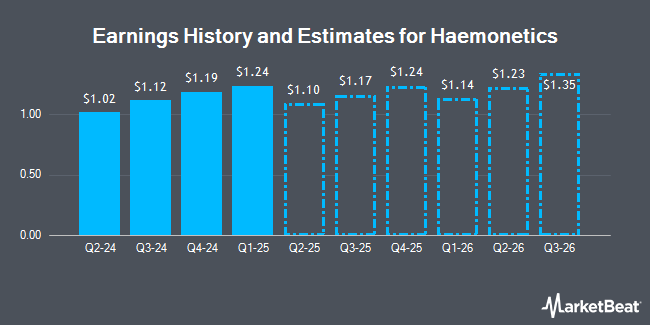Haemonetics (NYSE:HAE - Get Free Report) updated its FY 2025 earnings guidance on Thursday. The company provided earnings per share (EPS) guidance of 4.500-4.700 for the period, compared to the consensus estimate of 4.590. The company issued revenue guidance of $1.3 billion-$1.4 billion, compared to the consensus revenue estimate of $1.4 billion.
Wall Street Analyst Weigh In
A number of analysts have recently issued reports on the company. JMP Securities decreased their target price on Haemonetics from $125.00 to $100.00 and set a "market outperform" rating for the company in a report on Friday. Bank of America lowered Haemonetics from a "neutral" rating to an "underperform" rating and lowered their price objective for the company from $95.00 to $68.00 in a report on Friday. Barrington Research cut their price target on Haemonetics from $108.00 to $95.00 and set an "outperform" rating on the stock in a report on Friday. Raymond James reiterated a "strong-buy" rating and set a $115.00 price objective (down from $120.00) on shares of Haemonetics in a research report on Friday. Finally, JPMorgan Chase & Co. assumed coverage on Haemonetics in a research report on Friday, December 6th. They set an "overweight" rating and a $116.00 price target on the stock. One analyst has rated the stock with a sell rating, one has issued a hold rating, seven have assigned a buy rating and one has given a strong buy rating to the stock. According to MarketBeat, the company currently has a consensus rating of "Moderate Buy" and an average price target of $101.67.
Get Our Latest Stock Report on HAE
Haemonetics Stock Performance
HAE traded down $3.66 on Friday, hitting $59.34. The company had a trading volume of 2,702,592 shares, compared to its average volume of 959,630. The stock has a market cap of $2.98 billion, a price-to-earnings ratio of 23.36, a price-to-earnings-growth ratio of 0.98 and a beta of 0.39. The company has a debt-to-equity ratio of 1.35, a current ratio of 3.97 and a quick ratio of 2.09. The company's fifty day moving average price is $76.38 and its 200 day moving average price is $78.32. Haemonetics has a 1-year low of $59.09 and a 1-year high of $97.97.
Haemonetics (NYSE:HAE - Get Free Report) last released its quarterly earnings results on Thursday, February 6th. The medical instruments supplier reported $1.19 EPS for the quarter, missing analysts' consensus estimates of $1.20 by ($0.01). Haemonetics had a net margin of 9.47% and a return on equity of 23.66%. Equities analysts predict that Haemonetics will post 4.59 earnings per share for the current fiscal year.
Haemonetics Company Profile
(
Get Free Report)
Haemonetics Corporation, a healthcare company, provides suite of medical products and solutions in the United States and internationally. The company offers automated plasma collection systems, donor management software, and supporting software solutions including NexSys PCS and PCS2 plasmapheresis equipment and related disposables and solutions, as well as integrated information technology platforms for plasma customers to manage their donors, operations, and supply chain; and NexLynk DMS donor management system and Donor360 app.
Featured Stories

Before you consider Haemonetics, you'll want to hear this.
MarketBeat keeps track of Wall Street's top-rated and best performing research analysts and the stocks they recommend to their clients on a daily basis. MarketBeat has identified the five stocks that top analysts are quietly whispering to their clients to buy now before the broader market catches on... and Haemonetics wasn't on the list.
While Haemonetics currently has a "Moderate Buy" rating among analysts, top-rated analysts believe these five stocks are better buys.
View The Five Stocks Here
Discover the 10 Best High-Yield Dividend Stocks for 2025 and secure reliable income in uncertain markets. Download the report now to identify top dividend payers and avoid common yield traps.
Get This Free Report
Like this article? Share it with a colleague.
Link copied to clipboard.